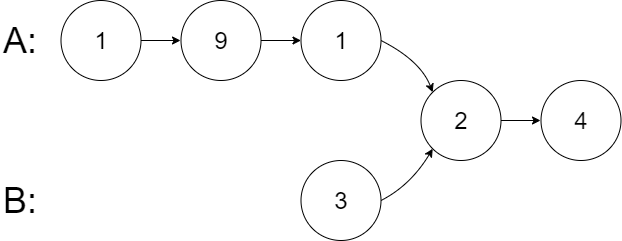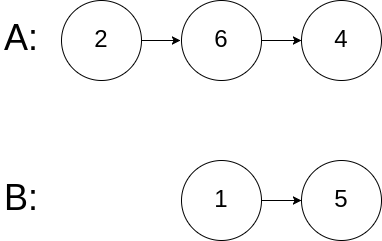题目描述
给你两个单链表的头节点 headA 和 headB ,请你找出并返回两个单链表相交的起始节点。如果两个链表不存在相交节点,返回 null 。
图示两个链表在节点 c1 开始相交:
题目数据 保证 整个链式结构中不存在环。
注意,函数返回结果后,链表必须 保持其原始结构 。
自定义评测:
评测系统 的输入如下(你设计的程序 不适用 此输入):
- intersectVal - 相交的起始节点的值。如果不存在相交节点,这一值为 0
- listA - 第一个链表
- listB - 第二个链表
- skipA - 在 listA 中(从头节点开始)跳到交叉节点的节点数
- skipB - 在 listB 中(从头节点开始)跳到交叉节点的节点数
评测系统将根据这些输入创建链式数据结构,并将两个头节点 headA 和 headB 传递给你的程序。如果程序能够正确返回相交节点,那么你的解决方案将被 视作正确答案 。
示例 1:
输入:intersectVal = 8, listA = [4,1,8,4,5], listB = [5,6,1,8,4,5], skipA = 2, skipB = 3
输出:Intersected at ‘8’
解释:相交节点的值为 8 (注意,如果两个链表相交则不能为 0)。 从各自的表头开始算起,链表 A 为 [4,1,8,4,5],链表 B 为 [5,6,1,8,4,5]。 在 A 中,相交节点前有 2 个节点;在 B 中,相交节点前有 3 个节点。
示例 2:
输入:intersectVal = 2, listA = [1,9,1,2,4], listB = [3,2,4], skipA = 3, skipB = 1
输出:Intersected at ‘2’
解释:相交节点的值为 2 (注意,如果两个链表相交则不能为 0)。 从各自的表头开始算起,链表 A 为 [1,9,1,2,4],链表 B 为 [3,2,4]。 在 A 中,相交节点前有 3 个节点;在 B 中,相交节点前有 1 个节点。
示例 3:
输入:intersectVal = 0, listA = [2,6,4], listB = [1,5], skipA = 3, skipB = 2
输出:null
解释:从各自的表头开始算起,链表 A 为 [2,6,4],链表 B 为 [1,5]。 由于这两个链表不相交,所以 intersectVal 必须为 0,而 skipA 和 skipB 可以是任意值。 这两个链表不相交,因此返回 null 。
提示:
- listA 中节点数目为 m
- listB 中节点数目为 n
- 1 <= m, n <= 3 * 104
- 1 <= Node.val <= 105
- 0 <= skipA <= m
- 0 <= skipB <= n
- 如果 listA 和 listB 没有交点,intersectVal 为 0
- 如果 listA 和 listB 有交点,intersectVal == listA[skipA] == listB[skipB]
进阶:你能否设计一个时间复杂度 O(m + n) 、仅用 O(1) 内存的解决方案?
个人解法
Javascript
方法1
/** @lc app=leetcode.cn id=160 lang=javascript** [160] 相交链表*/// @lc code=start/*** Definition for singly-linked list.* function ListNode(val) {* this.val = val;* this.next = null;* }*//*** @param {ListNode} headA* @param {ListNode} headB* @return {ListNode}*/var getIntersectionNode = function (headA, headB) {if(headA === null) return null;if(headB === null) return null;if (headA == headB) return headA;let temp = headA.next;while (temp !== null) {if (temp == headB) return temp;temp = temp.next;}return getIntersectionNode(headA, headB.next);};// @lc code=end
方法2
/** @lc app=leetcode.cn id=160 lang=javascript** [160] 相交链表*/// @lc code=start/*** Definition for singly-linked list.* function ListNode(val) {* this.val = val;* this.next = null;* }*//*** @param {ListNode} headA* @param {ListNode} headB* @return {ListNode}*/var getIntersectionNode = function (headA, headB) {const mySet = new Set();let tempA = headA;while (tempA) {mySet.add(tempA);tempA = tempA.next;}let tempB = headB;while (tempB) {if (mySet.has(tempB)) {return tempB;}tempB = tempB.next;}return null;};// @lc code=end

